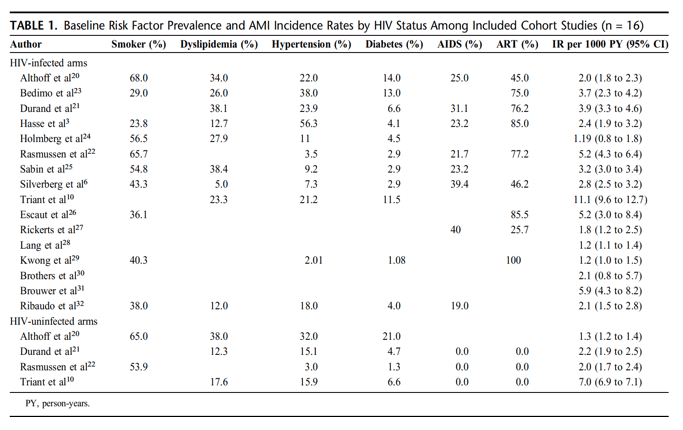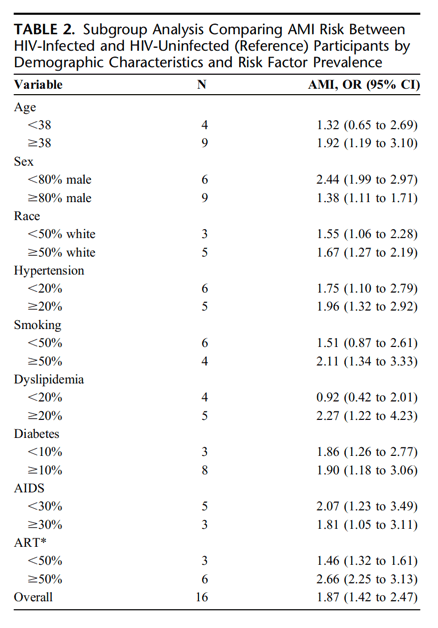| |
Heart Disease Risk Factors in HIV+
This study just published:
"Factors Associated With Excess Myocardial Infarction Risk in HIV-Infected Adults"
But there are key crucial points NOT covered in this meta-analysis study......
|
| |
| |
Download the PDF here
From Jules: CRUCIAL: other studies find undetectable viral load and good CD4 counts are protective so 1 study found PLWH with undetectable viral load did not have increased risk, and so high CD4 is also protective. It's complicated because some ARTs may increase risks associated with increased CVD risk, each specific ART risk is different. At this time integrate inhibitors are in general considered safer compared to other ARTs. HIV itself increases inflammation & immune activation despite viral suppression & high CD4 which may increase CVD risk. Stress, depression & anxiety & sleep disorders are likely not helpful, high blood pressure is not helpful, diabetes & high LDL is not good. Of course diet & exercise are very crucial in preventing heart disease. I think you have to weigh the variables: if a PLWH has undetectable VL & 700+ CD4 the risk from HIV itself may be limited, but if that person has bad traditional risk factors including diabetes, high cholesterol & triglycerides & LDL then risk for a CVD event is increased. in this study "HIV-related variables, including mean CD4 cell counts, viral loads, exposure to specific ART classes, and duration of HIV infection were inconsistently reported and could not be included in our analysis. For the same reason, we were not able to explore the effects of specific ART classes on MI risk or the effects of old vs. new drugs in our analyses". It is important to know that the 60% of HIV+ in care have detectable viral load (VL) so their risk for cardiovascular disease (CVD) is elevated and it is these people that I think drive these high rates. Still, as I say above even with <50 VL & 800 CD4 if you have lots of other risk factors: lifestyle, illicit drug use, smoking & very high lipids you are at increased risk. THIS IS FoR SURE TRUE as authors say: "Unless CVD risk is effectively managed in the HIV population, the gains in life expectancy conferred by antiretroviral therapies may be lost. Our findings underscore the importance of introducing aggressive management of traditional CVD risk factors such as hypertension, hyperlipidemia, diabetes, and smoking early in the care of HIV-infected individuals."
"Clinical Perspectives
As HIV-infected individuals are living longer because of effective ART, they now face an increased risk of morbidity and death caused by CVD. It is increasingly clear that appropriate HIV care requires not only chronic viral suppression, but also early recognition and management of cardiovascular risk factors. We found HIV-infected adults have 2 times the risk of AMI compared with HIV-uninfected individuals, and that traditional risk factors play a pivotal role in this increased risk. Our findings underscore the importance of introducing aggressive management of traditional CVD risk factors such as hypertension, hyperlipidemia, diabetes, and smoking early in the care of HIV-infected individuals. Unless CVD risk is effectively managed in the HIV population, the gains in life expectancy conferred by antiretroviral therapies may be lost."
http://www.natap.org/2014/CROI/croi_114.htm. "total and HDL cholesterol, and SBP were significant predictors of incident MI......each 300 cell/mm3 increase in current CD4 count was associated with a 25% decrease in the risk of MI, and higher HIV viral load was associated with a significant increase in MI risk
http://www.natap.org/2015/EACS/EACS_43.htm
http://www.natap.org/2013/HIV/102913_01.htm
http://www.natap.org/2011/CROI/croi_122.htm
http://www.natap.org/2010/HIV/081310_04.htm
http://www.natap.org/2018/IAC/IAC_111.htm
-------Chronic HIV infection is associated with a 2-fold higher AMI risk. Traditional risk factors such as hypertension, dyslipidemia, and smoking are significant contributors to AMI risk among HIV-infected adults and should be aggressively targeted in routine HIV care.
------We found HIV-infected adults have 2 times the risk of AMI compared with HIV-uninfected individuals, and that traditional risk factors play a pivotal role in this increased risk. Our findings underscore the importance of introducing aggressive management of traditional CVD risk factors such as hypertension, hyperlipidemia, diabetes, and smoking early in the care of HIV-infected individuals. Unless CVD risk is effectively managed in the HIV population, the gains in life expectancy conferred by antiretroviral therapies may be lost.
--------In a multivariate meta-regression (n = 7), participant median age, percentage of male participants, and prevalence of smoking, hypertension, diabetes, and dyslipidemia were associated with increased AMI risk. Each additional percentage point in the proportion of male participants [OR = 1.20 (1.14-1.27)] and each additional percentage point in the prevalence of hypertension [OR = 1.19 (1.12-1.27)], dyslipidemia [OR = 1.09 (1.07-1.11)], and smoking [OR = 1.09 (1.05-1.13)] were associated with 9%-20% greater AMI risk. Conversely, each additional year in median age [OR = 0.60 (0.50-0.72)] and diabetes prevalence percentage point [OR = 0.78 (0.73-0.83)] associated with 40% and 22% lower AMI risk, respectively.
---------Regarding risk factors for AMI, we found increases in the prevalence of hypertension associated with a 20% increased AMI risk, while increases in the prevalence of hyperlipidemia and smoking associated with a 9% increased risk each.
---------Our results align with evidence from other meta-analyses. For instance, a meta-analysis exploring CVD risk in HIV-infected adults found a 61% increased risk of composite CVD outcomes compared with HIV-uninfected adults, whereas a 2-fold increased risk was observed among those exposed to ART.14 Similarly, another meta-analysis reports a 60% greater AMI risk among HIV-infected compared with uninfected controls, and that ART use contributes to increased CVD risk.15 We found a 2-fold increase in AMI risk among HIV-infected groups compared with matched uninfected groups; this allows us to speculate that excess risk cannot be solely explained by differences in demographic characteristics and risk factor prevalence but may be linked to HIV-related factors and amplified by traditional risk factors.
data from 7 cohorts contributing to the NA-ACCORD study showed that eliminating smoking and hypertension in HIV-infected adults would avert 38% and 41% of AMI, respectively.33 Because HIV-infected adults have been found to have higher rates of smoking, dyslipidemia, diabetes, and hypertension than the general population,10,34 aggressive management of these risk factors is needed to reduce AMI risk in the HIV population.
------Subgroup analyses showed greater AMI risk in studies where ≥50% of participants had been exposed to any form of ART. Although this suggests ART has an impact on AMI risk, we were not able to parse out this association. We could not explore the link between specific ART classes and AMI risk because of incomplete reporting in included studies, whereeas other meta-analyses have implicated protease inhibitors and abacavir use in AMI risk.16 For the same reason, we could not explore the effect of older and newer drugs, an important aspect to explore given the change in therapies used in the early and current ART eras.36 Indeed some therapies used in the included studies are no longer first-line HIV therapies used in HIV care. It is therefore difficult to make valid conclusions about the link between ART use and AMI risk in the present analysis.
Factors Associated With Excess Myocardial Infarction Risk in HIV-Infected Adults
A Systematic Review and Meta-analysis
Rao, Shreya G., MDa; Galaviz, Karla I., PhDb; Gay, Hawkins C., MDc; Wei, Jingkai, MSPHd; Armstrong, Wendy S., MDe; del Rio, Carlos, MDb,f; Narayan, K.M. Venkat, MDb; Ali, Mohammed K., MDb
JAIDS Journal of Acquired Immune Deficiency Syndromes: June 1, 2019
Objectives: To estimate the pooled relative risk (RR) of incident acute myocardial infarction (AMI) among HIV-infected adults compared with HIV-uninfected controls and explore the contribution of traditional and HIV-related risk factors.
Background: Understanding AMI risk and associated risk factors in HIV-infected populations has the potential to inform clinical management and prevention strategies.
Methods: We systematically identified cohort studies of HIV-infected or HIV-infected and matched uninfected adults reporting AMI incidence rates published up to January 1, 2017. Random-effects meta-analysis models were used to estimate the aggregate RR of AMI by HIV status. Subgroup analysis and meta-regression were used to explore factors affecting risk.
Results: Sixteen studies (N = 1,619,690, median age 38.5 years, 78.9% male, mean follow-up of 6.5 years) were included. In pooled analyses of HIV-infected and matched uninfected cohorts (n = 5), HIV-infected individuals had higher AMI incidence rates (absolute risk difference = 2.2 cases per 1000 persons per year) and twice the risk of AMI [RR = 1.96 (1.5-2.6)] compared with matched HIV-uninfected controls. In a multivariate meta-regression, each additional percentage point in the proportion of male participants [odds ratio (OR) = 1.20 (1.14-1.27)] and each additional percentage point in the prevalence of hypertension [OR = 1.19 (1.12-1.27)], dyslipidemia [OR = 1.09 (1.07-1.11)], and smoking [OR = 1.09 (1.05-1.13)] were independently associated with increased AMI risk in HIV-infected adults.
Conclusions and Relevance: Chronic HIV infection is associated with a 2-fold higher AMI risk. Traditional risk factors such as hypertension, dyslipidemia, and smoking are significant contributors to AMI risk among HIV-infected adults and should be aggressively targeted in routine HIV care.

RESULTS
From the 2117 titles screened, 108 were selected for full text review and 16 were included in the meta-analysis (Fig. 1). Five studies included HIV-infected and matched uninfected cohorts,6,10,20-22 whereas 11 studies reported only on HIV-infected cohorts.3,23-32 Duration of study follow-up ranged from 1.8 years to 6.3 years. About half of the studies were conducted in North America (44%) and a third in Europe (31%). Characteristics of included studies are presented in Table 1, Supplemental Digital Content, http://links.lww.com/QAI/B292.
The 16 studies included 248,145 HIV-infected participants (median age 40 years, 81% male, 47% white) and 1,371,545 HIV-uninfected participants (median age 42 years, 77% male, 50% white). Risk factor baseline prevalence and AMI incidence rates reported in each study by HIV status are presented in Table 1. The average prevalence of hypertension in HIV-infected and uninfected individuals (19% vs. 15%, respectively), smoking (46% vs. 49%, respectively), dyslipidemia (22% vs. 18%, respectively), and diabetes (6% vs. 7%, respectively) did not significantly differ (P > 0.05). The average prevalence of AIDS reported across studies was 27%, whereas the average proportion of HIV-infected participants with exposure to ART was 67%.
In HIV-infected and matched uninfected cohorts (n = 5), the average AMI incidence rate was 5.0 cases per 1000 person-years (95% CI = 4.3 to 5.8) in HIV-infected individuals and 2.8 cases per 1000 person-years (95% CI = 2.6 to 3.0) in HIV-uninfected individuals (absolute risk difference = 2.2 per 1000 person-years). The random-effects meta-analysis (Fig. 2) showed HIV-infected participants have a 2-fold higher risk of AMI compared with HIV-uninfected participants [RR = 1.96 (1.48-2.57), I2 = 92.7%].
We grouped HIV-infected participants across the 16 studies included and compared AMI risk against that of HIV-uninfected participants included in 5 matched cohorts. HIV-infected participants had 87% greater odds of having an AMI event [odds ratio (OR) = 1.87 (1.42-2.47)] than HIV-uninfected participants. In unadjusted subgroup analyses exploring AMI risk in HIV-infected compared with uninfected individuals (Table 2), significantly greater odds for having an AMI event were observed in studies where >50% participants were exposed to any ART [OR = 2.66 (2.25-3.13)] compared with studies where <50% of participants were exposed [OR = 1.46 (1.32-1.61)]. Concerning traditional risk factors, significantly greater odds for having an AMI event were observed in studies with <80% male participants [OR = 2.44 (1.99-2.97)], than in studies with ≥80% male participants [OR = 1.38 (1.11-1.71)].
In a multivariate meta-regression (n = 7), participant median age, percentage of male participants, and prevalence of smoking, hypertension, diabetes, and dyslipidemia were associated with increased AMI risk. Each additional percentage point in the proportion of male participants [OR = 1.20 (1.14-1.27)] and each additional percentage point in the prevalence of hypertension [OR = 1.19 (1.12-1.27)], dyslipidemia [OR = 1.09 (1.07-1.11)], and smoking [OR = 1.09 (1.05-1.13)] were associated with 9%-20% greater AMI risk. Conversely, each additional year in median age [OR = 0.60 (0.50-0.72)] and diabetes prevalence percentage point [OR = 0.78 (0.73-0.83)] associated with 40% and 22% lower AMI risk, respectively.

|
|
| |
| |
|
|
|